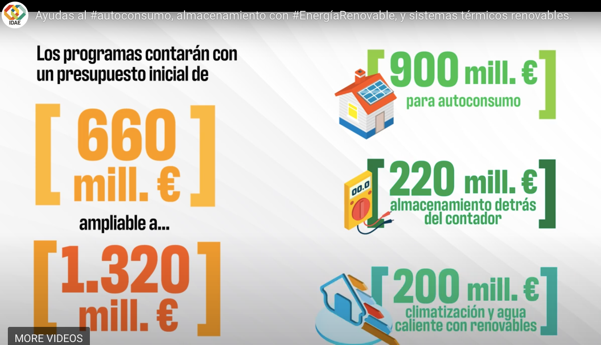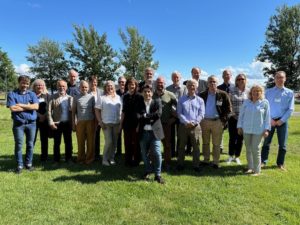

More than EUR 1 billion of incentives available in Spain
Solar thermal and heat pump technologies are currently benefiting from several incentive schemes in Spain. Until the end of 2023, these technologies are eligible for more than EUR 1 billion. For the first time, a subsidy especially for district heating & cooling has been approved with a budget of EUR 150 million. Altogether, five subsidy schemes have been implemented in the last 12 months within the framework of the Recovery, Transformation and Resilience Plan (PRTR). Prospective beneficiaries can submit their applications to the regional administration.
Source: IDAE
Pascual Polo, General Secretary of the Spanish Solar Thermal Association ASIT summarised the current status with the categorical statement “we are back on track”. Apparently, sales in the solar thermal sector dropped by 24 % between 2017 and 2021. The recent shower of money and public support may turn the tide.
Novelty: District heating and cooling given EUR 100 million
The most recently published budget line is the one for district heating and cooling with a budget of EUR 100 million. The Spanish Institute for Energy Diversification and Saving – IDAE administrates the scheme that intends to mobilise a total investment of around EUR 230 million and achieve the implementation of more than 320 MW of newly installed heating capacity. Municipalities and utilities can submit applications until 28 October 2022. Projects must be completed by June 2025.
The grants are capped at 35 % of the investment costs for large companies and 45 % for smaller ones. Companies or institutions located in municipalities with less than 5,000 inhabitants will receive a bonus of 5 % extra. There is a cap of EUR 15 million per project. Non-profit organisations – private and public – can also receive a subsidy of up to 75 % of the final cost in the case of a small municipality (70 % for the other institutions).
For the district heating incentive, the following types of project are eligible:
- New heating and cooling networks including heat-generation plants using exclusively renewable energies and distribution networks with heat exchangers to new heat energy consumers.
- Expansion of an existing plant by incorporating new-generation equipment using renewable energies.
- Expansion of an existing distribution network including the network itself and connections to new heat consumers. These projects must use existing generation plants that utilise renewable energies.
The thermal capacity of the plant must be larger than 1 MW. The grant level will be determined in the calls for proposals by the regions. According to the IDAE publication of 26 July 2022, the cap for solar district heating is 1,520 EUR/kWth. Biomass boilers are to be subsidised with a maximum of 950 EUR/kW and geothermal heat pumps with 2,070 EUR/kW.
Miguel Armesto from the Association of District Heating and Cooling Companies (ADHAC) is pleased with this first-ever subsidy scheme especially for district heating and cooling companies. However, some points could be improved. He sees the most significant handicap in the fact that all eligible projects exclude heat networks that are fuelled partly with natural gas. “Currently there are many hybrid heat networks using gas and this limits the access to the subsidies”, he said.
According to Armesto: “There are currently many grid projects and initiatives on paper waiting for a more favourable framework and these incentives could catalyse them.” Recently, the Spanish company Recursos de la Biomasa (Rebi) announced the development of a new district heating network including a 1 MW solar thermal plant in the city of Cuenca, 200 km east of Madrid.
Up to EUR 1,320 million for citizens-owned and non-profit institutions
The largest proportion of the incentives will be channelled through Royal Decree 477/2021, which in total provides EUR 660 million for all technologies. Most of this amount is aimed at photovoltaics and batteries for own-consumption. EUR 200 million is currently allocated for thermal technologies.
The package is divided into six components, of which component number 6 includes solar thermal installations. They will receive funding of 450 to 900 EUR/kW. The maximum amount per household is between EUR 550 and 1,800.
The funds are also being allocated regionally and they vary between EUR 17 million in Andalusia and EUR 136,000 in Melilla.
The deadline for submission of applications is 31 December 2023, but the funds may be exhausted earlier than this date. Last June the budget was increased by an additional EUR 550 million, reaching a total of EUR 1,210 million. The amount allocated for thermal technologies has not been published yet. Potentially available are even EUR 1,320 million.
According to Alejandro del Amo from Abora Solar, a Spanish PVT manufacturer one of the downsides of these incentives is that PVT technology is not eligible. “We think it will have to be reformulated in a next incentive scheme to allow this technology“.
According to Polo, this incentive scheme is positive, although, he expects that most of its funds will be spent on PV installations: “The current demand for PV is huge and most installers also prefer to go for PV as installation is simpler.” However, he is optimistic about its impact on the solar thermal sector.
| Programme | Target group | Total budget | Royal Decree and publication date | Applications can be submitted until | Further information |
| Renewable district heating and cooling | Municipalities / utilities | EUR 100 million | Orden TED/707/2022 of 21 July | 28 October 2022 | https://www.idae.es/sites/default/files/documentos/ayudas_y_financiacion/Redes-calor-y-frio/Resolucion%20convocatoria%20redes%20calor%20y%20frio.pdf |
| Own consumption and storage with renewable energy sources as well as the implementation of renewable thermal systems in the residential sector | Private companies and institutions |
EUR 660 million (can be increased to EUR 1,320 million) | Royal Decree 477/2021 of 29 June 2021 | 31 December 2023 – particular deadlines in each region | https://www.boe.es/diario_boe/txt.php?id=BOE-A-2021-10824 |
| For the implementation of thermal renewable energy installations in different sectors of the economy | Private companies and public institutions | EUR 150 million | Royal Decree 1124/2021 of 21 December 2021 | 31 December 2023 – particular deadlines in each region | https://www.boe.es/buscar/doc.php?id=BOE-A-2021-21106 |
| DUS 5,000 – Investments in unique local clean energy projects | Local authorities in small and demographically challenged municipalities | EUR 325 million | Royal Decree 692/2021 of 3 August 2021 | 4 November 2022 | https://www.boe.es/buscar/doc.php?id=BOE-A-2021-13269 |
| PREE 5000 – Energy rehabilitation and the reduction of final energy consumption and CO2 emissions in buildings | Private and public building owners or building operators in 6,827 municipalities with up to 5,000 inhabitants | EUR 50 million | Royal Decree 691/2021 of 3 August 2021 | 31 December 2023 | https://www.boe.es/boe/dias/2021/08/04/pdfs/BOE-A-2021-13268.pdf |
Overview of the five currently available incentives for renewable heating technologies in Spain
Solar thermal for companies and public institutions up to 70 %
In December 2021, Royal Decree 1124/2021 established the basic framework for a EUR 150 million incentive scheme for private companies and public institutions. The funds are currently being distributed and managed by the Spanish regions. The budget in each region depends on the size and population and varies between EUR 24 million in Andalusia and Madrid respectively and a low EUR 1.4 million in La Rioja.
This scheme allows a maximum of EUR 1,070 per kW for solar thermal systems and 1,000 EUR per kW for air-source heat pumps. The maximum subsidy is 35% for large companies and 45% for smaller ones. Companies operating in municipalities with less than 5,000 inhabitants will receive 5% extra. This means that a small company resident in a small village will receive 50% of the final system cost. The incentive for public institutions with economic activity is even higher, reaching a very juicy 70 % of the overall investment.
Organisations mentioned in this article:
ASIT: https://www.asit-solar.com/
ADHAC: https://www.adhac.es/
IDAE: https://www.idae.es/


